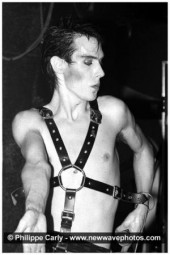"In the Beginning there was Punk.
Influences on dark wave stretch far further back, to Bowie, the Doors and the Velvet Underground, but the punk explosion of the mid/late 70s created the essential background for goth, in both music and fashion.
In the aftermath of punk in the late 70s and early 80s a bewildering variety of new and re-invented musical styles began to crop up, and around 1978-9 a style began to appear which the press had by late 1979 started to call "gothic".
The creators of this musical style were essentially Joy Division, Siouxsie and the Banshees, Bauhaus and UK Decay.
The first Banshees album and the first Joy Division album laid much of the template for goth, however, the first band who cannot be comfortably classified as anything other than goth were Bauhaus. The Banshees could be considered punk, The Cure could be considered New Wave, Joy Division could be considered post-punk, but Bauhaus were unmistakably goth in music, looks, lyrics, art and style right from their first single. In many ways they were the archetypal goth band.
Around the same time as Bauhaus were emerging, UK Decay were discarding their punk roots and developing their own independent "gothic" sound. Although never as popular as Bauhaus, Joy Division or the Banshees, UK Decay were far closer to the second wave of goth bands and were an important influence on them.
By 1980/81 a new wave of goth bands were beginning to emerge- Danse Society, Play Dead, The Sisters of Mercy- and the Cure had abandoned their New Wave sound and created a unique "gothic" sound of their own. In February 1981 Abbo from UK Decay tagged the new musical movement "gothic", but it was to be another year or so before the movement really got going.
In July 1982 the Batcave opened up.
This was at first envisaged as a club for people who were fed up with the commercial direction of New Romantic and wanted something new and darker. At first it played glam and electro music, but several early goth bands also played there and the playlist gradually became more goth.
The Batcave thus became a major rallying-point for the emerging London scene and also attracted a lot of media attention, which in turn spread the idea of a new subculture around the country. In the wake of the Batcave, similar clubs opened around the country, and the Batcave itself went "on tour", giving goths outside London somewhere to gather.
Thus, whilst offering little in the way of music (apart from ASF and Specimen), the Batcave had a major impact on goth fashion and popularity. Essentially, it added a huge dose of "glam" and media attention to the emerging subculture.
The new wave of goth bands also began receiving serious media attention, with Southern Death Cult getting a front cover on the NME and Sex Gang Children getting a front cover on Noise!
the term "gothic" had been floating around for a while, and the name was fixed to the emerging scene by two of the most important bands in it: Andi, the lead singer with Sex Gang Children, was tagged "Count Visigoth" and his followers tagged "goths" by Ian Astbury from Southern Death Cult. Dave Dorrell from the NME then overheard them using the term and it passed into journalistic use."http://www.scathe.demon.co.uk/summary.htm
You have been marked on my profile map! Click to zoom-in.
